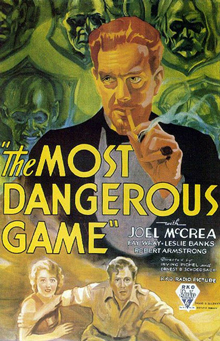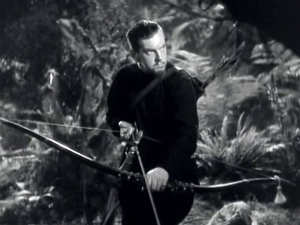
 |
|
|
|
Film fans just becoming aware of the Pre-code era in Hollywood don't always realize that 1934 enforcement of the Production Code went beyond forbidding frank sexual subjects and putting an end to crime movies that glorified gangsters. The church-dominated Code Office also acted to snuff out the horror film, discouraging producers from making fantasies about unnatural monsters, morbid obsessions and sadistic cruelties. That leaves the bottom-of-the-Depression years 1931-1933 as the pinnacle of Dangerous Ideas in Hollywood pictures. While crime films criticized the country's worship of success by any means possible (The Public Enemy), or declared that the only solution to injustice and corruption might be revolution (I Am A Fugitive from a Chain Gang), horror pictures shocked the public with gory mutilations, medical blasphemies and bizarre bestiality. When the Code came in, many of these films were post-censored for reissue or simply withheld from distribution for decades. Others, like 1932's The Most Dangerous Game, were shortened before release, because their producers felt they had "gone too far" in a couple of scenes. 
Based on Richard Connell's short story, The Most Dangerous Game consists of a 45-minute prelude to a deadly hunt on a remote Malaysian island. Big game hunter Bob Rainsford (Joel McCrea) is part of a millionaire's hunting expedition in the South Seas when their yacht strikes rocks and sinks while trying to navigate a narrow passage. The only survivor, Bob discovers a European-style castle inhabited by a Cossack expatriate, Count Zaroff (Leslie Banks). With his three servants, the imposing Zaroff is playing host to the survivors of a previous shipwreck, Eve and Martin Trowbridge (Fay Wray & Robert Armstrong). Zaroff is intrigued to discover that his newest guest is a famed hunter, but Eve takes Bob aside to confide her fear that something is not right. Something is very wrong: the madman-murderer Zaroff intentionally wrecks passing ships with false buoy lights, and then uses any survivors to indulge his perverse pleasure: hunting human beings. Zaroff eyes his fellow hunter and then the attractive Eve, declaring that both shall serve his aesthetic ambition: "First the hunt, then the revels!" Realizing that their big RKO production King Kong would have a long post-production period, Merian C. Cooper and Ernest Schoedsack filmed The Most Dangerous Game at night to make extra use of that picture's enormous jungle sets. The first thing that modern audiences notice is that Zaroff's island looks almost exactly like Kong's Skull Island, with its Gustav Doré- inspired jungle. We see familiar animated birds and the same effect methods used to make traveling mattes. The two films share a number of identical settings, such as a steamy swamp and a massive tree that serves as a bridge across a chasm. Most viewers catch on to the presence of Kong actors Robert Armstrong and Fay Wray. Skull Island native chief Noble Johnson and 'witch doctor' Steve Clemente are here as well, in whiteface as Cossack and Asian servants. Game also shares with Kong an impressive music score by Max Steiner. The adventure concepts of both movies spring from the idea that a remote island might very well hide some fantastic secret, be it a giant prehistoric monster or aristocratic maniac who likes to hunt people. The opening aboard the yacht quickly establishes the identity of Bob Rainsford, and then replays the 'pirate wrecker' theme familiar from movies about dastardly smugglers. That a castaway on an uninhabited island suddenly finds himself in a luxurious palace is pure pulp nonsense -- we aren't supposed to wonder how Zaroff maintains this enormous castle yet keeps his presence on the island a secret. Instead, audiences of 1932 were in for one shock after another. Bob regards an ominous mural depicting a centaur-like creature carrying off a female victim, while Eve gets increasingly nervous over her brother's incessant drinking. Leslie Banks' Zaroff is a real original, a Russian boogeyman character whose good-host manners cannot disguise his crazy obsessions. Zaroff poses in his tuxedo and speaks almost exclusively in portentous riddles, assuming that Rainsford will share his warped ideas about The Hunt always coming before The Woman. 
I've read The Most Dangerous Game interpreted along homoerotic lines, what with Zaroff appealing to Rainsford to share in his perverse utopia. From this remove in time we're more likely to wonder why Rainsford doesn't simply pretend to join Zaroff's Happy Hunting Club and then double-cross him at the first opportunity. Bob and Eve are released into the jungle wearing the clothes on their backs, while Zaroff appears suddenly wearing an all-black hunting getup. It's not quite a kinky cat suit, but the effect is the same -- the 'real' Zaroff is now out in the open, wearing his Freak Costume. As in Kong, the dense studio-constructed jungle is a fantastic effect in itself. It is said to be "no bigger than a deer park" yet is large enough to contain a swamp, and a raging river complete with dramatic waterfalls. The jungle chase has its violent moments but of course is neither as savage nor as ruthless as movies made later. Rainsford rigs some nasty mantraps, but the contest is mostly a game of hide-and-seek. The violent showdown is reserved for a delayed surprise climax. Does Zaroff play fair? The movie is critical of hunters, to be sure. By extension, it makes killing animals for sport seem all the more cruel and cowardly. Rainsford is let loose in an unfamiliar setting with only a knife, while Zaroff has his hunting bow and his servants as aides. When he can't catch Rainsford, he switches to a high-powered rifle and looses a pack of hunting hounds. Despite Zaroff's Chess-game talk about hunting a resourceful, thinking opponent, he didn't really lay down any specific rules. Rainsford is reduced to little more than human prey. In terms of film horror, The Most Dangerous Game is an almost pure expression of filmic sadism. Zaroff maintains a torture chamber for opponents that won't play his game, and his secret trophy room is decorated with the decapitated heads of his victims. The two ghastly examples we see are more than adequate to push the movie into horror territory. We're told (through the researches of the late George Turner) that the trophy room scene was originally much longer. Zaroff displays for his captives a couple of waxwork-like dioramas of earlier victims, telling the stories behind their horrible deaths. Deleted before release, this lost footage has joined the legendary Kong Spider Pit Scene in the dream imaginations of fans of movie horror. 
Actor Leslie Banks didn't specialize in villains and could be counted on to play suave characters in a less stylized fashion. Hitchcock cast him to play the hero in the original The Man Who Knew Too Much. Joel McCrea is appropriately rock-jawed and heroic, and more immediately personable than either Bruce Cabot or Randolph Scott, the man's-man heroes of Cooper and Schoedsack's King Kong and She. Fay Wray is Fay Wray -- called upon to do little more than be threatened, mistreated and devastatingly beautiful, we accept her as a Beauty imperiled by another kind of Beast. The Pre-code ability to directly address edgy subject matter is still shocking -- Zaroff's unambiguous stares at Eve say, "I AM GOING TO KILL THIS MAN AND THEN COME BACK AND RAPE YOU." This outrageous threat prevents The Most Dangerous Game from becoming a cinematic fossil. 1 Richard Connell's story has been frequently remade or adapted for a new setting: Run for the Sun, The Running Man, Battle Royale. The latest similar film hit is last year's The Hunger Games This is not exactly an off-topic thought... some sources say that the original Paint Ball outdoor hunting game begun in 1976 was directly inspired by Richard Connell's story and RKO's movie. I always found the concept of Paint Ball to be objectionably anti-social... it's at heart a sadistic fantasy activity. Flicker Alley's Blu-ray of The Most Dangerous Game is a phenomenal restoration; I would never have thought this show would ever again look this good. The liner notes say that Lobster Films remastered the picture from the studio's fine-grain positive, which prompts a grateful bow in the direction of Serge Bromberg (and David Shepard of Blackhawk Films). Except for a few dings here and there, a couple of shots taken from a less-perfect source and some abrasions on the extreme right of the picture, the show looks almost new. It is now possible to pick out fine details in the special effects. Even better, the transfer retains the original surface texture of the images, including the original granularity of the film stock. We at last can hear all of the dialogue on the carefully restored audio track. This transfer far outpaces the previous best, a Criterion disc from 2001. Best forgotten is a 2008 colorized edition supposedly 'authorized' by Ray Harryhausen. The encoding comes with a full and informative commentary by Rick Jewell, the author of a new book on RKO Studio history, and an archival audio interview with Merian C. Cooper recorded by Kevin Brownlow. A major extra billed as a second feature is the exploitation documentary Gow, The Headhunter. As explained in a pamphlet insert essay by Eric Schaefer, Gow began as a silent film from the 1920s showing tribal customs on various South Seas Islands. Outfitted in 1931 with a sarcastic narration to emphasize a spurious cannibalism motif, the movie was reissued more than once with newer and more outrageous exploitation ballyhoo. At one point in the show, the biased narrator tells us that "the censor" forced the filmmakers to cut out actual scenes of cannibal feasting, the exact same content that the publicity claims will be shown. Gow's presence here is relevant because Cooper and Shoedsack worked as cameramen on the original, anthropologically-sincere voyage to document the islanders' disappearing customs. Gow is in fine shape as well. It comes with the informative Eric Schaefer essay and some stills of marquees showing it under its 1950s title Cannibal Island.
On a scale of Excellent, Good, Fair, and Poor,
The Most Dangerous Game & Gow Blu-ray rates:
Footnotes:
1. After the Code was enforced, Hollywood bad guys and monsters continued kidnapping and roughing up fair damsels for decades -- without actually doing anything to them. Part of the absurd charm of Creature from the Black Lagoon is that the slimy gill man desires the girl, but is (visibly) unequipped for "the revels". Hypocritical censorship certainly created some strange sex fantasies.
Reviews on the Savant main site have additional credits information and are often updated and annotated with reader input and graphics. Also, don't forget the 2011 Savant Wish List. T'was Ever Thus.
Review Staff | About DVD Talk | Newsletter Subscribe | Join DVD Talk Forum |
| ||||||||||||||||||